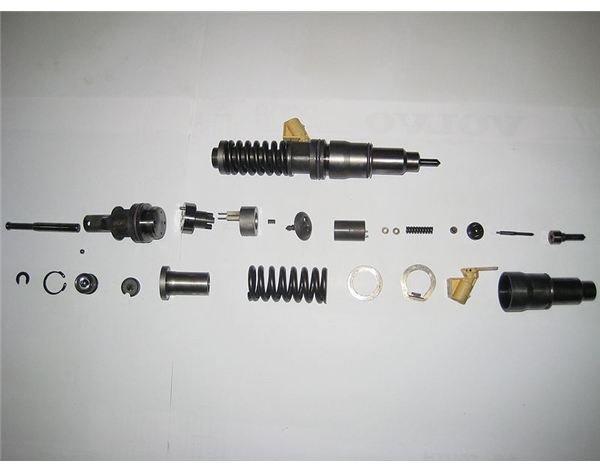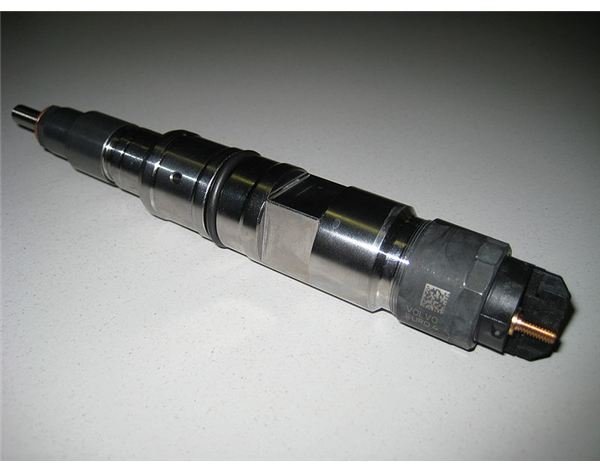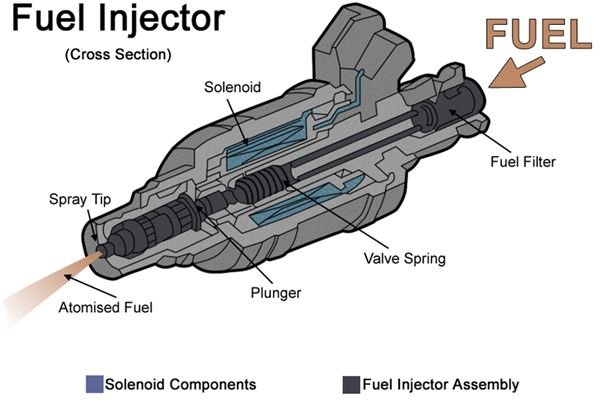How does Fuel injection Work? Working of Fuel Injection System (FIS)
Carburetion was, for a long time, the method of choice for mixing the air and fuel and introducing it into the intake system of internal combustion engines. Fuel injection, a much more efficient system that creates more horsepower was originally designed for diesel engines. In the fifties Chevrolet introduced fuel injection on their high performance Corvette model. The system has been gaining in popularity ever since, and its most basic operation is described first below. Listed next you will be presented with the major parts of most fuel injection systems, along with their function. Once a familiarity with the basics and function is obtained, the two main types of injection systems in use will be described.
The Operation of the Fuel injection System
The original fuel injection systems used a fuel distributor to inject the fuel for each cylinder individually, in order of cylinder firing. This fuel distribution system is still in use on larger engines. In most fuel injected systems, sensors measure the volume of air entering the engine and the temperature of the exhaust stream, and the computer commands the injector(s) to pulse for a specific amount of time. The length of the pulse and the fuel pressure determine the volume of fuel that is delivered. Air is metered by the throttle plate, which moves in conjunction with the accelerator pedal. Fuel injection atomizes the fuel much better than carburetion, which gives injection its boost in efficiency and power.


The Parts of a Fuel Injection System
The parts of a fuel injection system exist either to deliver the fuel to the injector(s), or to supply information that the control unit requires in order to provide the most efficient engine operation possible.
Fuel storage and delivery components include the fuel tank, pump, and lines. The fuel pump is capable of supplying up to sixty PSI of fuel pressure, so the fuel lines and connections are designed to withstand pressures almost double that.
Your car will have either two injectors, or one per cylinder, and sometimes one extra. In throttle body injected vehicles, there will be two injectors, and with port injection systems, there will be a single injector for each cylinder, plus sometimes an accelerator/cold start injector.
One way that injected fuel volume is controlled is by restricting the length of time that the injector is pulsed for. Metering fuel pressure to the injector is the other and is accomplished using a fuel pressure regulator, which can be pre-calibrated, vacuum- or electrically-controlled.
Most fuel injection systems have at least four sensors: the throttle position sensor uses a rheostat to determine how much acceleration you desire. The Mass Air Flow sensor determines how much air is entering the intake system. The oxygen sensors measures exhaust temperature, which is interpreted to determine whether the engine is running lean or rich. A sensor that determines crankshaft position tells the system which cylinder will fire next. This sensor is also required by the ignition system; on most cars, this is a crankshaft position sensor, a camshaft position sensor, or, on some cars, both.
Various Injection Schemes
There are several variations in fuel injection design. The Throttle Body Injection, or TBI or a single point injection system, injects fuel at the throttle body,

similar to a carburetor. The induction mixture passes through the intake manifold runners. Fuel spraying constantly was then achieved by the continuous jet injection system introduced in 1974 where gasoline is pumped from the fuel tank to a large control valve called a fuel distributor that distributes the fuel to the series of smaller pipes of each injector. General Motors then implemented the central port injection, or CPI or central port fuel injection, which uses a tube with poppet valves from a central injector to spray the fuel at each intake port rather than the central throttle body. There is also the multi-point fuel injection system that injects fuel into the intake ports rather than at a central point within the engine manifold. Another example is the direct injection used by diesel engines where the injection nozzle is placed inside the combustion chamber.
References
- Image: Fuelinjector.png from wikimedia commons by Wikipedian Prolific under the GNU Free Documentation License.
- Image: Jaguar AJ16 throttle body from wikimedia commons by Magnus Back and is from the Public Domain.
- Image: Delphi E 1 Unit Injector from wikimedia commons by Pahona under the Creative Commons Share Alike 3.0 License.
- Mike Aguilar has over 30 years experience in the auto industry and has taken numerous fuel injection courses.
- Image: Bosch common rail injector from wikimedia commons by Panoha under the Creative Commons Share ALike Unported License.
